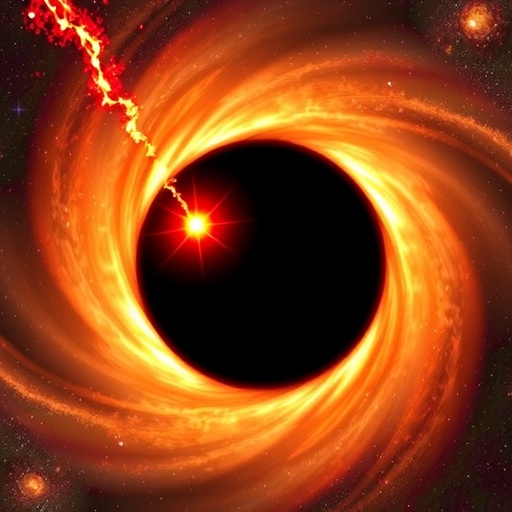In a groundbreaking study published in The Astrophysical Journal, an international team of astronomers has made a remarkable discovery that significantly alters our understanding of black holes and their behavior in the universe. For the first time, they have identified a tidal disruption event (TDE)—an astronomical phenomenon where a black hole tears apart a star—occurring outside the galactic center. This event, designated AT 2024tvd, marked an unprecedented observation of exceptionally strong and rapidly evolving radio emission from a black hole, challenging our long-held beliefs about the locations and dynamics of supermassive black holes.
Led by Dr. Itai Sfaradi and Professor Raffaella Margutti from the University of California, Berkeley, this study has garnered contributions from researchers worldwide, including prominent physicist Professor Assaf Horesh from the Hebrew University of Jerusalem. The collaborative effort demonstrates the power of global scientific cooperation and innovative observational techniques in unraveling the complexities of our universe.
Tidal disruption events are rare phenomena that occur when a star strays too close to a massive black hole, succumbing to its overwhelming gravitational pull. The AT 2024tvd event was particularly notable because the black hole in question was situated approximately 2,600 light-years from its host galaxy’s core. This finding provides compelling evidence that supermassive black holes can exist in locations previously thought to be devoid of such massive celestial bodies. The implications of this discovery extend far beyond the individual event, inviting astronomers and astrophysicists to reconsider the distribution of black holes across the cosmos.
The significance of the radio emissions from AT 2024tvd cannot be overstated. This event produced what is now regarded as the fastest-evolving radio emission ever documented from a black hole-driven stellar disruption. The team utilized a suite of advanced radio telescopes including the Very Large Array (VLA), ALMA, ATA, and the Arcminute Microkelvin Imager Large Array (AMI-LA) to gather high-quality observational data that led to these extraordinary findings. The rapid evolution of the radio signals highlights the dynamic processes occurring around black holes, offering a fresh perspective on how these entities interact with their surrounding environments.
Dr. Sfaradi remarked on the significance of their findings, stating, “This is truly extraordinary. Never before have we seen such bright radio emission from a black hole tearing apart a star, away from a galaxy’s center, and evolving this fast. It changes how we think about black holes and their behavior.” Such rapid changes in radio brightness suggest that the ejection of material from the discrepancy between the black hole and the disrupted star might not occur immediately, but can instead unfold over several months.
As the researchers delved deeper into the data, they uncovered a remarkable sequence of two distinct radio flares emitted from the event. These flares emerged unexpectedly, evolving at an unprecedented pace and indicating that powerful outflows of material were launched from the black hole well after the initial stellar disruption had taken place. This delayed response signifies a complex interplay of material dynamics and black hole activity that has previously gone unnoticed in other TDE occurrences.
This new understanding of black hole activity is transformative; it suggests that such cosmic entities can enter periods of apparent dormancy only to “reawaken” later, launching bursts of activity. The methodologies employed by the research team, including advanced modeling techniques, provide insights into the mechanics of black hole emissions, offering a tantalizing glimpse into the erratic nature of these cosmic giants.
The collaboration also enlisted the expertise of numerous scientists from various institutions across the United States, Europe, and Israel, ensuring a multidisciplinary approach to the research. Among them, Professor Paz Beniamini of the Open University of Israel contributed critical insights into the radio properties of the TDE. This collective effort underscores an essential aspect of scientific inquiry: collaboration and shared knowledge lead to unparalleled breakthroughs.
Looking forward, the implications of this discovery extend beyond theoretical astrophysics. As we cultivate our understanding of black holes situated outside galactic centers and refine our observational capabilities, we will likely witness even more revelations about these enigmatic cosmic features. This research not only broadens our understanding of black holes but also hints at the potential for discovering more TDE events in similar anomalous regions.
Astronomy stands on the precipice of a new era, where unexpected findings challenge prevailing theories and lead to fresh inquiries. Scientists will undoubtedly revisit previously established models of galactic structure and black hole distributions in light of these findings, fostering deeper investigations into our universe’s fundamental mechanics.
In conclusion, the AT 2024tvd discovery represents a momentous leap forward in our comprehension of black holes and the violent interactions they engender. As the scientific community continues to unravel the mysteries of the cosmos, this event serves as a potent reminder of the endless possibilities that await in the universe’s dark reaches, reinforcing the notion that our understanding is always evolving.
Subject of Research: Tidal disruption events in relation to black holes
Article Title: The First Radio-Bright Off-Nuclear TDE 2024tvd Reveals the Fastest-Evolving Double-Peaked Radio Emission
News Publication Date: 15-Oct-2025
Web References: DOI link
References: The Astrophysical Journal Letters
Image Credits: NSF/AUI/NSF NRAO/P.Vosteen
Keywords
Tidal disruption event, black holes, astronomical phenomena, supermassive black holes, radio emissions, galactic center, astrophysics, stellar disruption, cosmic dynamics, observational astronomy.




